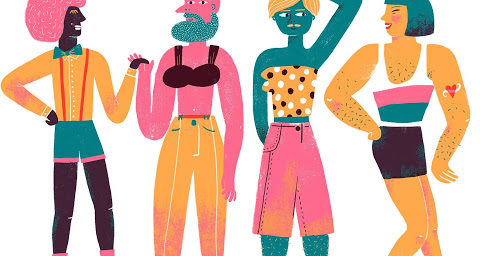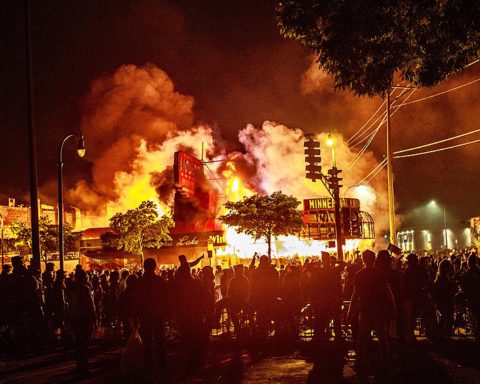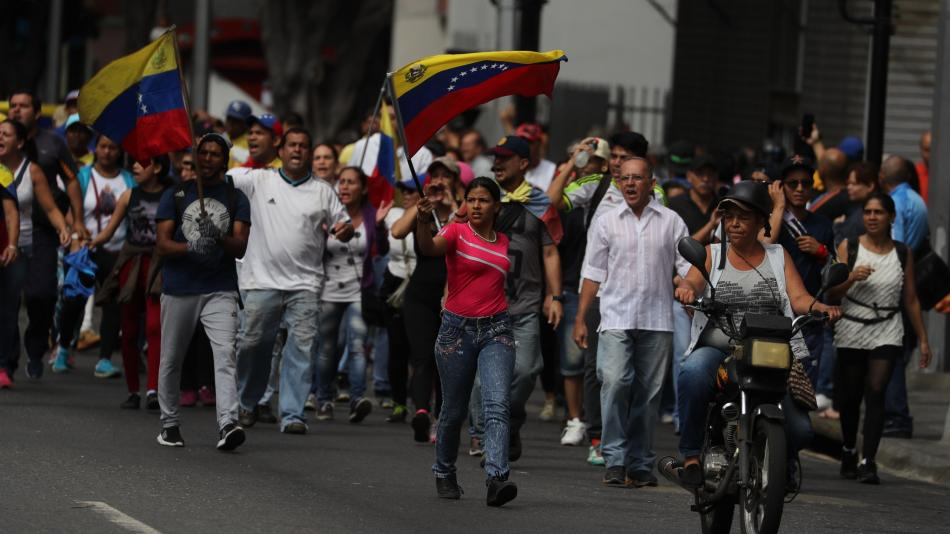This pandemic comes to the United States at a time in which millions of people are in extreme poverty and misery, unable to feed themselves, living on the streets. The real virus that kills is capitalism.
Pablo Estere
OES-CEICS
Throughout the world, the ongoing suffering of the working class became justified by an exceptional situation: the pandemic. Acording to this explanation, unemployment, lack of payment of wages, shortages, lack of or deficitary access to the health system, among others, are its logical consequence. This view seeks to establish that, on the one hand, capitalism would have nothing to do with poverty or hunger, but that external and random factors called «crises» would be responsible. And that, on the other hand, this crisis would be a temporary event whose effects would not take place in a “normal” situation. But on the contrary, as it so happens, the world economy has been in crisis at least since the 1970s and the Coronavirus has come to act as a catalyst for the crisis, accelerating trends already present.
In the United States, the media coverage of the pandemic reveals scenes typical of an apocalyptic hollywood film. Long lines of people at food banks to get a free box of basic necessities. In two months, more than 30 million newly unemployed people were recorded, which increases the need to provide greater food rations. This is not science fiction, but a social crime perpetrated by the bourgeoisie. Is it an exceptional event, something just characteristic of this pandemic? Do poverty and hunger arise now as a result of the coronavirus? No. In the United States, the greatest international power, which accounts for a quarter of the global economy with a population that represents barely 4% of the world population, it is not possible to hide what is inherent to capitalism: hunger and poverty. Here on we describe the social situation prior to the arrival of the virus.
Between Africa and Latin America
This pandemic comes to the United States at a time when millions of workers are in extremely poor conditions. In effect, the Census Bureau, the official body in charge of measuring poverty in the United States, reported that in 2018 11.8% of Americans were poor, that is, about 38.1 million people. As is always the case with official measurements, these figures underestimate the number of poor people, as occurs with INDEC in Argentina or INE in Chile, since the basket used to measure poverty is based on the consumption of the poorest population. According to consumption patterns of the average population, poverty levels measured by income would increase from 20 to 25%, that is, around 65 million people would be poor in 2018.
For millions of Americans, eating every day is not secured. The U.S has a food aid program (SNAP) whose motto is «Ending hunger and moving people forward to self sufficiency». As we can see, the hunger situation in the country is acknowledged but at the same time it’s expected that the system will work these issues out and that these initiatives will not be permanent. However, if we analyze the evolution of the number of beneficiaries, there is a pronounced upward trend both in absolute terms and as a percentage of the population. When the program was implemented in 1969, it benefited 2 million people. Before the 2008 crisis, SNAP reached 25 million. Today it reaches more than 37 million people with a monthly entitlement that averages USD 130 per person.
In addition, there are other federal food assistance programs, such as The Emergency Food Assistance Program (TEFAP), the Commodity Supplemental Food Program (CSFP) or the Child and Adult Care Food Program (CACFP). There are also programs focused on school-age children such as the National School Lunch Program (NSLP), which serves daily meals to more than 29.5 million students, or the School Breakfast Program (SPB), which in January exceeded 14.8 million children being assisted. Aditionally, the SFPS works during the summer school break. Another very widespread program is WIC that serves single mothers and children up to 5 years old, which in January of this year reached more than 6 million beneficiaries.
Despite all this gigantic battery of programs and food plans provided by the State, in the United States there is a non-governmental structure dedicated to social assistance. We find that many NGOs are dedicated exclusively to the distribution of food among the poorest population. One of them is Feeding America. This NGO assists 40 million people every year and denounces that SNAP is insufficient, since it establishes a very “thrifty” food budget that the NGO estimates would be 30% below the minimum necessary for each month. How does this NGO procure the food it then distributes? The foundation receives donations of unsold food from companies within the food industry for its «food banks».
It should be noted that, due to restaurants closing down during the quarantine, Feeding America warned that donations dwindled, at the same time that the food demand would increase due to millions of people being put out of work. Within this context, the NGO estimates that in the coming months some 17 million more people than usual will go hungry in the United States, a figure that is equivalent to an increase of 46%.
On the other hand, the federal government allocates a substantial amount of direct income transfers in the shape of assistance programs, directed at other layers of surplus population for capital or the unemployed. These handouts include the Supplemental Security Income Program (SSI) and the Temporary Assistance for Needy Families Program (TANF). SSI is intended for low-income and/or disabled seniors, although children under 18 with disabilities may also qualify. It currently has more than 8 million beneficiaries who receive a monthly benefit whose amount depends on the formal income they have, since the running concept is to supplement the income of each household. In order to qualify as a beneficiary, a person cannot earn an income above USD 2000 monthly or above USD 3000 for a couple. The maximum amount that a person can receive is USD 783, USD 1175 per couple, and an additional USD 392 for each child they have. This means that the handout only covers 60% of what’s necessary to surpass the poverty line.
TANF, for its part, focuses on temporarily assisting low-income families who are going through a critical situation. Last year it reported assistance to more than 1 million families, of which at least 80% received food assistance through SNAP and medical assistance. 10% of TANF beneficiary families also received some type of housing subsidy. Families can only access this program for 24 months in time spans of 5 years, since one of its goals is for families to achieve economic self-sufficiency through job training and help in job placement. In addition, half of its members must work at least 30 hours a week to stay in the program, although time worked for childcare, volunteer services, or participation in job training workshops can be counted in. The monthly payment depends on the State in which it is processed and the composition of the family, but nationally it averages USD 430.
The high number of recipients of assistance programs offered by the goverment does not include the immigrant and undocumented population residing in the United States. This people living in pauper and miserable conditions, either unemployed or holding very precarious jobs consist of an estimated 10 to 12 million peoplein the period 2010-2017 according to some surveys. A figure that is very conservative, since the undocumented avoid being surveyed and registered for fear of being uncovered and, consequently, deported. In fact, about 250,000 deportationsof illegal immigrants take place each year. There are millions of poor people who are not accounted for by official records.
As we can see, this pandemic reaches the country headed by Donald Trump at a time when millions and millions of people not only need direct assistance from the State to survive, but who also cannot feed themselves regularly.
Homelessness
Access to housing is another significant difficulty for Americans, especially in large cities where the real estate business does not prioritize the development of housing for the working class. As an example, the average rentin New York in 2019 was around 82% of the American mean income.
Indeed, it is estimated that in the United States 35% of households rent their homes. Aimed at this population which pays a very high percentage of their income in rent, the State allocates aid programs to help make rent more affordable. At the federal level, to name a few examples, emergency temporary rent subsidies are given, private condominium subsidies to reduce the rent to selected beneficiaries, or state homes that charge below-market rent. At the state and local level, there are regulations such as rent freeze for local residents. A Census Bureau publication estimated in 2018 that, without this battery of subsidies, the number of the poor would increaseby almost 3 million. However, these subsidies are not sufficiently enough. A substantial portion of the population cannot meet the rent payment and are expelled from their homes. Princeton University estimates that between 2003 and 2016, one million families were evicted per year because they were unable to pay their rent.
The most notorious problem of access to housing is the number of homeless people. Official figures currently record more than 500,000 homeless Americans. About 200,000 live in places not intended for housing, such as parks, sidewalks, abandoned cars or subway stations, while about 300,000 sleep in shelters or refuges. Thus it can be distinguished those homeless folks with and without a shelter. 47% of homeless without shelter are located in California (mainly San Francisco and Los Angeles), where the percentage is 4 times higher than the national average. A fifth of the homeless who have access to a shelter are in New York, and the cities that follow in number are Boston and Washington.
Although this half million represents only 0.2% of the population, their presence in large cities is more noticeable. 45% of the homeless are in 5 states that represent 20% of the population. Whereas the national average is 17 homeless per 10,000 inhabitants, in these cities it is considerably higher: Washington DC (103), Boston (102), New York (103). Although there is a downward trend, the number of homeless people has remained above 500,000 in the last 10 years.
Official surveys try to count the number of homeless people in an area in a single night to avoid double counts, since these are people who do not always stay in the same place and who are not easy to interview. In addition, there are particularly conflictive locations where accurate surveys cannot be guaranteed. All these conditions add up to the alredy present governments’ intention to hide or minimize negative social indicators. However, certain institutions dedicated to issues related to homelessness register higher figures. For example, AIR’s National Center on Family Homelessness points out in one of its latest reports published in 2014 that the number of underage children without a home in the United States alone would be of roughly 2.5 million per year. Therefore, the official figures would be far from reflecting the reality of the homeless.
To fully grasp the conditions in which thousands of homeless people in the United States are subjected, it suffices to look at an emblematic case. In the heart of Los Angeles, in just 1.12 km², the Skid Row neighborhood concentrates more than 4,700 homeless. Many of its sidewalks are impassable because they are crowded with tents, garbage and junk that accumulates from all that is collected on the streets by all of those who stay there. There are complaints of gangs that run those blocks and charge up to USD 200 a month to stay or demand compensation ranging from drug trafficking to prostitution. Before such a picture of social decomposition, the neighborhood is a fixed target of both state and non-governmental assistance.
As we can see, homelessness is the most visible symptom of the social situation that surrounds this pauperized population. If the pandemic is wreaking havoc across the country, it is not hard to imagine what could happen in these scenarios. At the end of April, 43 positive cases of COVID-19 were detected in a single Skid Row shelter, further spread is expectedwhile massive testing continues in the area.
Red dream
The situation of the working class in the United States is nothing like the promise of the American dream. The country that produces the greatest wealth on the planet cannot provide shelter or food for millions of its inhabitants. On top of this situation, the pandemic has already killed more Americans than the Vietnam War. Neither the invisible hand of the market nor the welfare state can solve that which is caused by the social relations that rule this world. The Statue of Liberty, the highest monument to capitalist society, testifies to what Marx said: «a worker is a slave who must seek his master». Only a socialist society can make freedom real, because it will guarantee the enjoyment of social wealth for all its members.






